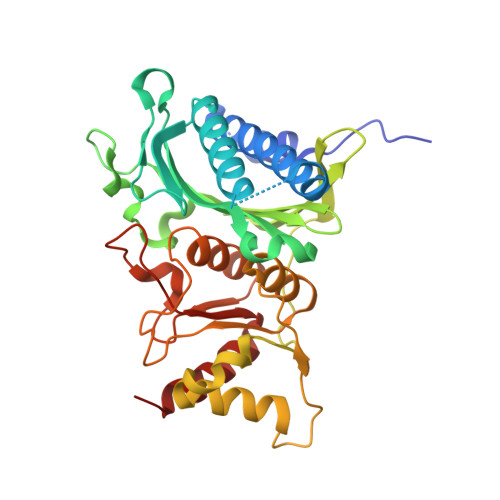Quadruple space-group ambiguity owing to rotational and translational noncrystallographic symmetry in human liver fructose-1,6-bisphosphatase.
Ruf, A., Tetaz, T., Schott, B., Joseph, C., Rudolph, M.G.(2016) Acta Crystallogr D Struct Biol 72: 1212-1224
- PubMed: 27841754
- DOI: https://doi.org/10.1107/S2059798316016715
- Primary Citation of Related Structures:
5LDZ - PubMed Abstract:
Fructose-1,6-bisphosphatase (FBPase) is a key regulator of gluconeogenesis and a potential drug target for type 2 diabetes. FBPase is a homotetramer of 222 symmetry with a major and a minor dimer interface. The dimers connected via the minor interface can rotate with respect to each other, leading to the inactive T-state and active R-state conformations of FBPase. Here, the first crystal structure of human liver FBPase in the R-state conformation is presented, determined at a resolution of 2.2 Å in a tetragonal setting that exhibits an unusual arrangement of noncrystallographic symmetry (NCS) elements. Self-Patterson function analysis and various intensity statistics revealed the presence of pseudo-translation and the absence of twinning. The space group is P4 1 2 1 2, but structure determination was also possible in space groups P4 3 2 1 2, P4 1 22 and P4 3 22. All solutions have the same arrangement of three C 2 -symmetric dimers spaced by 1/3 along an NCS axis parallel to the c axis located at (1/4, 1/4, z), which is therefore invisible in a self-rotation function analysis. The solutions in the four space groups are related to one another and emulate a body-centred lattice. If all NCS elements were crystallographic, the space group would be I4 1 22 with a c axis three times shorter and a single FBPase subunit in the asymmetric unit. I4 1 22 is a minimal, non-isomorphic supergroup of the four primitive tetragonal space groups, explaining the space-group ambiguity for this crystal.
- pRED, Therapeutic Modalities, F. Hoffmann-La Roche, 4070 Basel, Switzerland.
Organizational Affiliation:



















